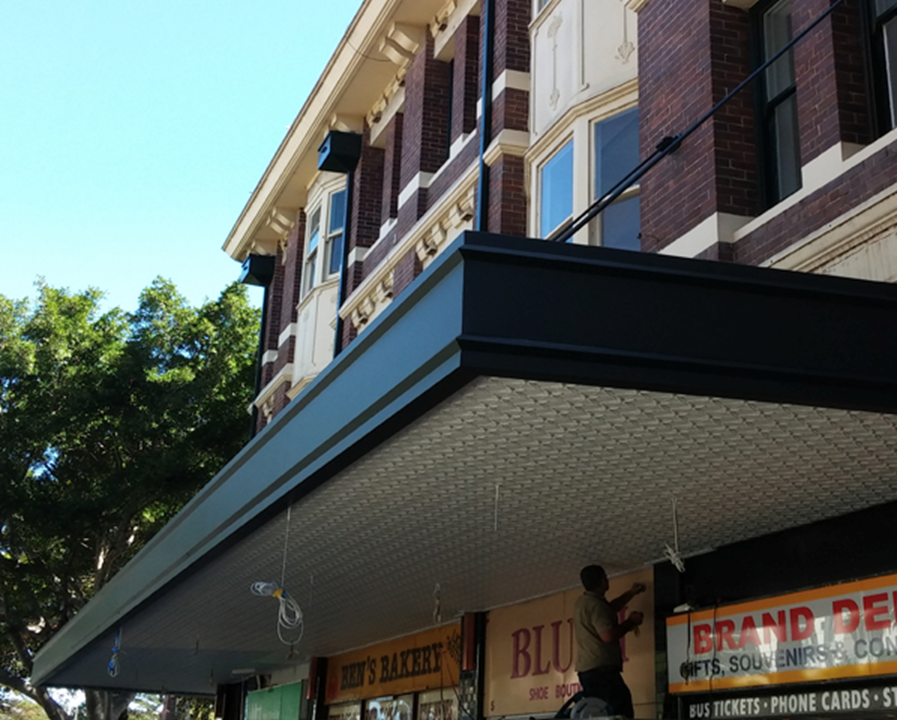Did you know that awnings are part of the buildings to which they are attached? This makes them the responsibility of the owner of the building, even when an awning is located over a public footpath.
An example awning structure is shown in Figure 1 for reference.
Figure 1 – Typical awnings structure example

Awnings provide protection from the elements such as sun and rain, noting that the structural components of awnings are generally out of sight and therefore out of mind. If awnings are not maintained, they will increasingly pose a public health hazard, especially if a catastrophic structural failure occurs.
In response to recent accidents involving the collapse of awnings over public lands (e.g. shopfront, dining areas etc.) in Australia and to discharge their duty of care obligations, many local government Councils have implemented processes to ensure that awnings are structurally assessed regularly.
Awnings with an unusual design or which do not allow the structural connections between the awning and supporting structures to be easily inspected can be particularly high risk as their condition cannot be easily ascertained.
Dilapidated awnings are a potential public health hazard and the building owner may be liable for the injury or death of a person due to a defective awning. To mitigate this risk, it is recommended to have engineers inspect and advise on the structural integrity of awnings, and where necessary, to advise on repair, rehabilitation or replacement for Council approval.
Typical risks encountered with awnings that can contribute to structural failure include:
- Defective anchorage systems (at poor installation or due simply to deterioration);
- Deteriorated steel elements;
- Wall cracking;
- Concealed support connections that cannot be easily inspected; and
- Other construction related deficiencies.
Table 1 – Summary of key stakeholders
|
Stakeholder |
Recommended Action |
| Councils | Implement policies and inspection programs that aim to strike a balance between thoroughness and practicality to achieve the maximum stakeholder engagement and the maximum reduction in risk of awning collapse.
This may include the development of awareness programs for building owners, the development of procedures to determine the structural adequacy of awnings, and the development of ongoing inspection programs. |
| Engineers / Designers | Engineers and designers should consider the following factors when designing the awning:
|
| Contractors / Builders | General
The principal contractor should implement an effective quality assurance (QA) system to ensure the procedures for installing anchorages comply with the design specification. This includes inspection of the anchorages prior to loads being applied. The QA system may also include conducting proof loading on anchors (this is particularly important for insert type anchors designed for ‘pull out’ loads).
Person Installing Anchors Workers installing anchors should be trained in the correct installation method as specified by the anchor manufacturer. If the installer is unable to install the anchor effectively, a suitably qualified engineer should provide guidance on alternative anchorage systems to be used. |
| Building Owners / Managers | Existing Awnings
Awnings should be regularly inspected and maintained. Where the awning has a support system that cannot be readily or easily inspected, parts of the awning may need to be removed so that an adequate inspection can be completed with minimal risk to the inspector or members of the public. Where there is a likelihood that the awning will collapse, the awning should be repaired, or removed and replaced with a new awning, giving consideration to the design elements mentioned above.
Awning Alterations Never make structural alterations to buildings, or attach additional architectural features, unless the building designer or an engineer provides written certification. This includes the addition of signs, sails, hoardings or other attachments to a structure. Local government authorities should also be consulted about requirements for building additions. |
If engineering certification is required to confirm the structural adequacy of an awning structure, the recommended procedure is outlined in Table 2.
Table 2 – Typical inspection process for awnings over public spaces
|
Stage |
Description |
| Stage 1 Initial Inspection |
|
| Stage 2 Detailed Inspection (If Required) |
|
| Stage 3 Engineering Report |
|
| Stage 4 Engineering Calculations (If Required) |
|
| Stage 5 Final Inspection (If Required) |
|
| Stage 6 Certification (If Required) |
|
